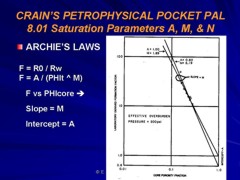|
 Crain's Usage Rules for
SelectinG WATER SATURATION Method
Crain's Usage Rules for
SelectinG WATER SATURATION Method
The answers for all the water
saturation solutions will vary, and in some
cases will be unreasonable or impossible to calculate due to lack of
data. In order of preference, we would choose:
 BEST MODEL
BEST MODEL
1. Simandoux Model
Use whenever possible. Rreverts to Archie Model when Vsh
= 0.
Works reliably in conventional and unconventional
reservoirs.
Cannot create negative saturation answers.
 OTHER SATURATION MODELS
OTHER SATURATION MODELS
Use only within
limitations
2. Archie Model
Use in clean sands or
carbonates. Use Simandoux to handle both clean and shaly
rocks.
3. Rwa Model
Use in clean sands or carbonates.
4. Dual Water Model
Eeverts to Archie Model when Vsh = 0. Czn create
negative saturation answers.
5 Waxmzn - Smits Model
Requires CEC and Qv data which is hard to
find.
6. Buckles Model
Use when resistivity is missing.Also used to
find irreducible water saturation SWir in water zones.
7. Resistivity Ratio Model.
Use when porosity is missing.
8. TDT / PDK / RST / Pulsed
Neutron Models
Use in cased hole for reservoir monitoring.
9. Sppecial Cases
Pyrite corrections, laminated reservoirs, fractured
reservoirs.
10. Many alternate models are covered in this Handbook.
 Triming Water Saturation RESULTS
Triming Water Saturation RESULTS
Trim
shale volume and porosity before using them in water
saturation equations.
Water saturation results must be constrained by the following:
1:
IF Sw < 0
2: THEN Sw = 0
3: IF Sw > 1.0
4: THEN Sw = 1.0
Where:
Sw = water saturation from any method (fractional)
 COMMENTS:
COMMENTS:
Only
the bulk volume water (dual water) method could create a
negative water saturation.
All
methods can create values greater than 1.0 (100%). If too many
points are over 1.0, water resistivity, shale resistivity, porosity,
and shale volume parameters should be reviewed.
 Water Saturation Smoothing
Water Saturation Smoothing
Schlumberger
proposed a smoothing function to reduce statistical noise in saturation
data at both the high and low ends of the spectrum.
1:
IF Sw > 0.75
2: THEN Sw = (1 - ((16 / 3) (1 - Sw) ^ 3) * (5 - 128 * (1 - Sw)
^ 3))
3: IF Sw < 0.25
4: THEN Sw = Sw + 0.04 * (1 - 4 * Sw) / (1 + 21 * Sw)
Otherwise
Sw is unchanged.
Where:
Sw = water saturation from any method (fractional)
 COMMENTS:
COMMENTS:
The smoothing function is not necessary for hand calculator work,
especially if Sw data is rounded to the nearest 0.05 (or 5%).
The function prevents water saturation from going below 0.04 (4%).
|


